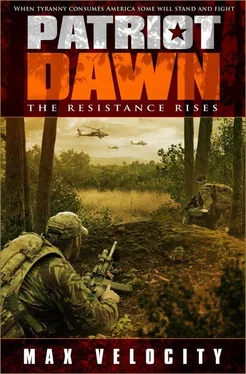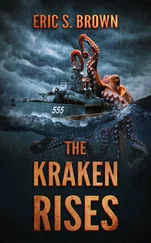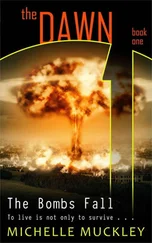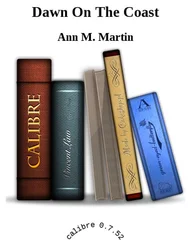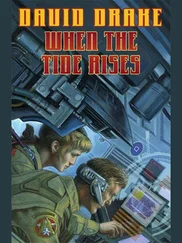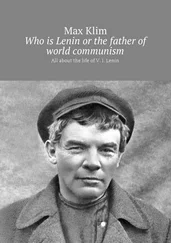“Down Jasper, down,” he laughed.
At the sound of his voice, Sarah and Connor came running out to him, “Daddy, Daddy!” and he picked them up in his arms.
As Jack walked past the wooden partition into the family area, Caitlin looked up from what she was doing at the table at him, smiled, and then sensed his mood and her face changed.
“Hi Hon,” she said, “What’s the matter?”
‘Hey, I missed you. And you guys too!’ he said, turning to the two kids with a smile. “Bill was here,” he continued, “Major Cassidy is gone.”
She looked at him, her mind working.
“So, honey, I was thinking…” he started.
She made the connection in a flash.
“Oh no. No you don’t Jack Berenger, that wasn’t the deal.”
“Hon, they need me.”
“We need you,” she replied.
“I know, I’m sorry, I promise I’ll be careful, but this is something I have to do.”
“Damn it Jack, there is nothing truer than that I know you. I should have guessed. This is just typical.”
Jack stood there like a klutz, both kids in his arms. “Look Hon, I’m sorry.”
She turned back to the table, “It’s FINE, don’t worry about it.
Clearly it wasn’t fine.
“Fine,” he said.
“Fine,” she said, face to the desk.
“Come on kids, let’s go for a walk.”
Later, the kids were sleeping and he was sitting at the table in their partitioned area when she came up behind him, put her arms around his neck, and her cheek onto his.
“I’m sorry Hon, I love you,” Jack said.
“I love you too. Just don’t get hurt.”
Come early January, the training was progressing well. Bill had sent the support weapons they had requested and they had begun to train a fourth platoon as a fire support element. They had two mortar squads with three barrels each. There were two machine-gun squads who had a choice of 240 or .50cal weapons depending on the task at hand. They also had several men trained up as .50cal Barrett rifle shooters.
Luckily amongst the veterans that had been recruited they had some with relevant experience, either as machine-gunners or mortar men. This made the training process smoother and allowed them to identify trainers for these specialist weapons.
The training had been pretty tough through the winter, the harsh cold and wet was a constant challenge, exacerbated by barely adequate rations. As they had anticipated, some of those being trained had fallen off the course, either voluntarily withdrawing or being told they would be better elsewhere. A steady flow of new recruits had allowed them to reach the desired four platoon Company strength.
About fifty percent of the women had not made it through the training, finding jobs elsewhere within the organization but leaving a hard core behind, spread across the platoons. Some of the women, although not allocated to the fighting Company, had been kept as covert assets to be used by the IED cells or for covert recon tasks.
They had begun to deploy the four man IED/shooter teams. These teams would be taken out of the training for a week at a time, given IEDs and an area to operate in, to include several miles of road. They would deploy and conduct harassing IED operations on the routes used by Regime convoys and patrols, attempting to disrupt Regime movement through the Shenandoah Valley.
Jim had his metal shop up and running and was creating the off-route mines, otherwise known as explosively formed penetrators or EFPs. These were set at the side of the road and angled for a shot into a passing vehicle. The explosives behind the copper cone would detonate and shoot an ‘incoherent spray’ of molten metal at the target, burning through the armor with the molten slugs.
It was a related process to the way a HEAT warhead or RPG worked, but with the difference that the EFP was set off the road away from the vehicle, whereas the RPG warhead detonated on the side of the vehicle and used the Monroe effect to fire a molten jet, or stream, through the armor.
The EFP was unstoppable by the Regime armored vehicles but the vital factor was accurate targeting. It had to fire at the right time and strike the enemy vehicle in the right place. The thing about EFPs was that, for example, one could strike through the cab of a vehicle, but leave everyone in the back unharmed. This is why they were often deployed as a targeted array of multiple devices in the Middle East, for maximum damage.
Jim designed the initiation system straight from the briefs he had received and the examples he had seen of recovered devices while on deployment. The device would be triggered when a vehicle broke the beam of an infra-red (IR) ‘tripwire’ set across the road. The distance between this trip beam and the EFP itself determined where on the vehicle the device would hit.
In order to avoid striking the wrong vehicle, or civilians for instance, the beam would be turned on by an observer using a remote device, from a distance. The Regime troops had not so far been deployed with electronic counter measure (ECM) equipment to disrupt such attacks, but as the IED campaign continued no doubt they would.
The ECM protection created a bubble around the convoy within which the remote controlled devices would not work. This meant that for the EFP, timing was critical: it was to be switched on when the convoy was imminent, but not too late so the ECM would counter attempts to turn it on with the remote device. Initially, there were failures due to experimentation and inexperience.
The EFP was the key device that they deployed with. It had the advantage of being a hybrid of a remote controlled IED, but at the same time it was victim operated and the detonation was tied to the placement of the IR beam.
When the IED team deployed, it was more of a covert operation than the more conventional side of the Resistance operations they were training for. They shed most of their overt irregular fighter garb and went as low profile as possible, equipment and battle belts with jackets and such.
The teams would select a kill site within their allocated area of operations using whatever intelligence they had supplemented by their own recon. The two IED specialists would covertly place and camouflage the EFP by the side of the route and fall back to an OP where they could over-watch the device. The two shooters would usually be deployed in a separate location in order to provide early warning and cover for the withdrawal.
The teams took to taking the thermal ponchos on these OP missions with them, because they could set up and lay in the OP under the ponchos and avoid any aerial surveillance. As the campaign progressed through the month of January they started to see more and more ‘top cover’ flights by helicopters equipped with FLIR, forward looking infra-red. Sometimes these would be AH (attack helicopters: Apaches), sometimes even just police surveillance helicopters. The Regime intent was to conduct a route clearance ahead of any convoys utilizing their FLIR equipment.
Through the Resistance network and also from previous missions into the valley, the Company was building up a database of information on the valley, patterns of the Regime convoys and patrols, and also useful places to lie up. There were places that were known to be available, such as barns and sheds on the land of sympathizers, convenient wooded copses and the like, where IED teams could lie up while out on mission.
Along with the lay-up points, sometimes co-located or in separate areas, was a network of caches for food supplies that would be checked and refilled routinely by local sympathizers. This was working well for the Resistance, and maintaining the support of the people in the valley was essential.
Jack knew that if the attention of the Regime really began to focus on the valley, with detailed surveillance and Intel gathering assets, then some of this network would be exposed to reprisals.
Читать дальше
